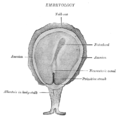Primitive streak: Difference between revisions
CSV import |
CSV import Tags: mobile edit mobile web edit |
||
| Line 32: | Line 32: | ||
{{stub}} | {{stub}} | ||
{{dictionary-stub1}} | {{dictionary-stub1}} | ||
== Primitive streak == | |||
<gallery> | |||
File:Gray13a.jpg|Gray13a | |||
File:2908_Germ_Layers-02.jpg|2908 Germ Layers-02 | |||
File:Gray14.png|Gray14 | |||
File:Formation_of_the_Primitive_Streak.pdf|Formation of the Primitive Streak | |||
File:Gray17.png|Gray17 | |||
File:Gray21.png|Gray21 | |||
</gallery> | |||
Latest revision as of 21:00, 23 February 2025
Primitive Streak
The Primitive Streak is a structure that forms in the blastula during the early stages of avian, reptilian, and mammalian embryonic development. It establishes bilateral symmetry, determines the site of gastrulation and initiates germ layer formation. The primitive streak is the earliest trace of the embryo in the fertilized ovum.
Formation[edit]
The primitive streak forms during the third week of embryogenesis. It begins as a small area of epiblastic cells at the caudal end of the embryonic disc. These cells proliferate and migrate towards the cranial end of the disc, forming a raised streak. This process is known as gastrulation.
Function[edit]
The primitive streak serves several key functions in embryonic development. It establishes the longitudinal axis of the embryo and determines the bilateral symmetry of the organism. It also serves as the site of gastrulation, the process by which the three germ layers (ectoderm, mesoderm, and endoderm) are formed.
Clinical Significance[edit]
Abnormalities in the formation of the primitive streak can lead to a variety of congenital disorders. These include caudal dysgenesis, sirenomelia, and situs inversus. In addition, the primitive streak is the site of origin for teratomas, a type of germ cell tumor.
See Also[edit]
References[edit]
<references />








